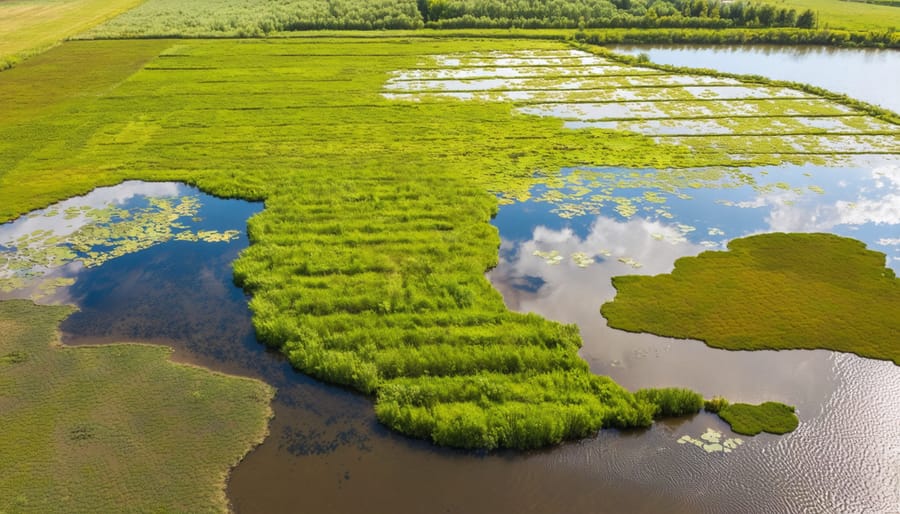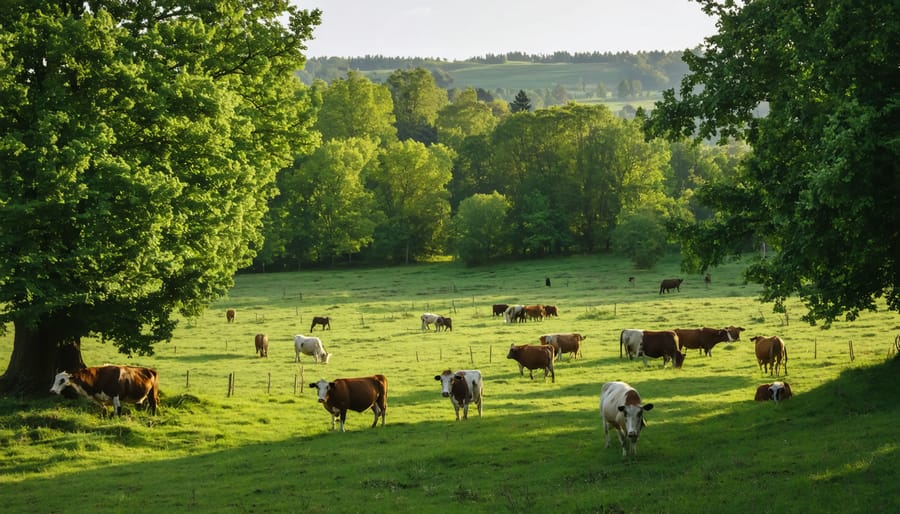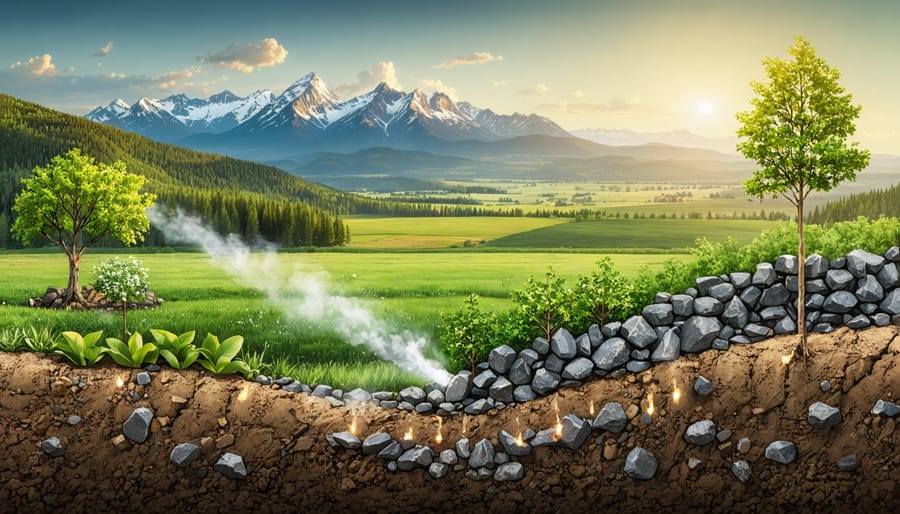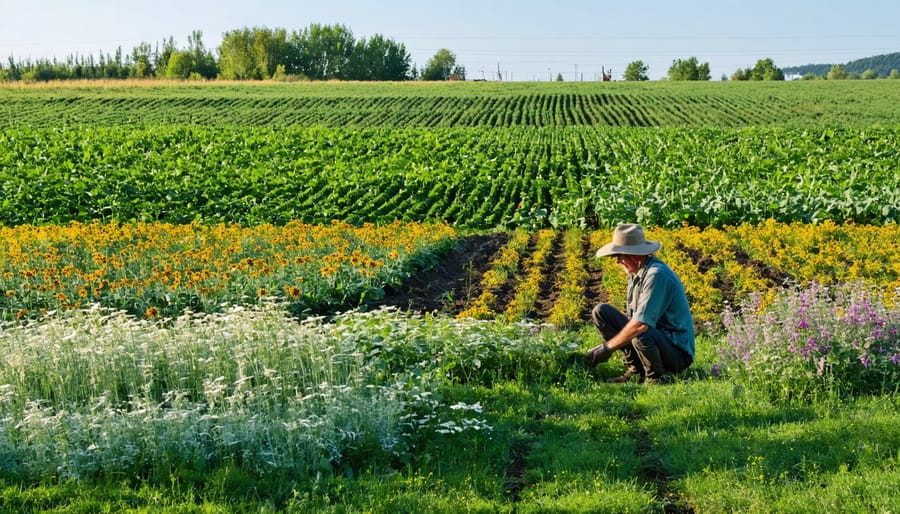Wetlands stand as nature’s most efficient carbon capture systems, storing up to 50 times more carbon per hectare than our Alberta forests. These vital ecosystems, from prairie potholes to boreal peatlands, lock away millions of tonnes of carbon while providing essential habitat for wildlife and natural flood control for farming communities. Recent research shows that restored wetlands on agricultural land can sequester up to 2.5 tonnes of carbon per hectare annually – a game-changing opportunity for Canadian farmers looking to diversify income through carbon credits while enhancing their land’s resilience to climate extremes.
For Alberta’s agricultural community, wetland carbon sequestration represents more than environmental stewardship – it’s becoming a cornerstone of sustainable farm management and economic opportunity. Through targeted restoration projects, farmers across the province are already transforming degraded wetlands into productive carbon sinks, earning carbon credits while improving water quality and supporting local biodiversity. As carbon markets mature and government incentives expand, understanding how to effectively manage wetlands for carbon sequestration has never been more relevant to the future of Canadian agriculture.
Why Wetlands Are Nature’s Carbon Vaults
The Science Behind Wetland Carbon Storage
Wetlands act as nature’s carbon vaults through a fascinating process that makes them incredible allies in climate change mitigation. These ecosystems excel at carbon sequestration practices through their unique soil conditions and plant life.
When plants in wetlands photosynthesize, they pull carbon dioxide from the atmosphere. What makes wetlands special is their waterlogged soil conditions, which slow down decomposition significantly. This means that when plant material dies, it doesn’t break down as quickly as it would in dry soil. Instead, this organic matter accumulates in layers, forming peat and storing carbon for hundreds or even thousands of years.
Here in Alberta, our prairie potholes and marshlands are particularly effective at this process. The cool climate and seasonal flooding create ideal conditions for carbon storage. A single hectare of healthy wetland can store up to 300 tonnes of carbon in its soil – that’s equivalent to taking about 65 cars off the road for a year.
The best part? This natural process continues year after year, making wetlands some of our most valuable allies in sustainable land management.

Alberta’s Wetland Potential
Alberta’s wetlands represent one of our province’s most valuable natural climate solutions, with the potential to store significantly more carbon than our forests. These ecological powerhouses cover approximately 20% of Alberta’s landscape and have been sequestering carbon for thousands of years.
Our province’s wetlands, particularly in the Boreal region, can store up to 250 tonnes of carbon per hectare – that’s roughly equivalent to the annual emissions of 50 cars. What makes Alberta’s wetlands especially effective at carbon storage is their unique composition of peat and organic matter, combined with our distinct climate conditions.
Recent studies by the University of Alberta show that well-maintained wetlands in our agricultural regions can sequester between 2 and 5 tonnes of carbon per hectare annually. This remarkable capacity not only helps mitigate climate change but also provides essential ecosystem services like flood control and water filtration, directly benefiting our farming communities.
For Alberta farmers, understanding and preserving these wetland areas represents both an environmental responsibility and an opportunity for sustainable land management.
Practical Steps to Restore Your Wetland
Assessment and Planning
Before starting any wetland restoration project, it’s essential to thoroughly assess your land’s potential and develop a comprehensive plan. Begin by mapping out existing and historical wetland areas on your property using aerial photographs and soil surveys available through Alberta Agriculture Services.
Consider conducting a detailed site evaluation, which should include soil sampling, water table measurements, and vegetation surveys. Local conservation authorities can help identify optimal locations for wetland restoration based on factors like topography, drainage patterns, and existing wildlife corridors.
Work with qualified wetland specialists to determine your land’s carbon sequestration potential. They can help estimate the expected carbon storage rates based on wetland type, size, and local climate conditions. In Alberta, prairie pothole wetlands typically sequester between 2.4 to 3.8 tonnes of carbon per hectare annually.
Your restoration plan should outline:
– Clear project objectives and timeline
– Required permits and regulatory compliance
– Construction and engineering requirements
– Native plant species selection
– Water management strategies
– Monitoring and maintenance protocols
– Cost estimates and potential funding sources
Remember to engage with neighbouring landowners early in the planning process, as wetland systems often cross property boundaries. Many Alberta farmers have found success by collaborating on larger restoration projects, sharing resources and expertise while maximizing ecological benefits.
Consider joining local wetland stewardship programs, which offer technical support and connect you with experienced mentors in your area.
Restoration Techniques
Successful wetland restoration requires a careful, step-by-step approach that builds on natural processes. The first critical step is assessing the site’s hydrology and establishing proper water management practices. This often involves removing drainage tiles or blocking ditches to restore natural water levels.
For Alberta farmers, native plant selection is crucial. Choose species like cattails, bulrushes, and sedges that are well-adapted to local conditions. These plants not only help stabilize soil but also accelerate carbon storage. Consider working with local nurseries that specialize in wetland species for best results.
Soil preparation plays a vital role in restoration success. Remove invasive species and excess nutrients that might compete with native plants. Adding organic matter can jump-start microbial activity and enhance carbon sequestration potential.
Timing is everything – plan restoration activities for early spring or fall when soil moisture levels are optimal. This gives plants the best chance of establishment before extreme weather conditions set in.
Monitor water levels regularly and maintain appropriate depths for your chosen plant species. Installing simple water control structures can help manage seasonal fluctuations and prevent unwanted flooding or drying.
Remember to document your restoration progress through photos and measurements. This information is valuable for future management decisions and may be required for carbon credit programs or environmental certifications.
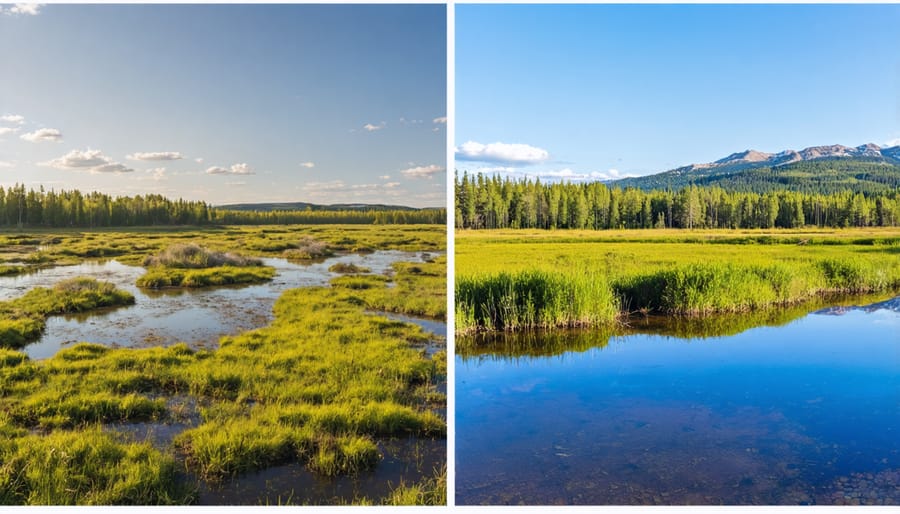
Maintenance and Monitoring
Regular monitoring and maintenance are essential for ensuring your wetland continues to effectively sequester carbon while providing other ecological benefits. In Alberta, we’ve found that successful wetland projects typically require seasonal check-ups, particularly during spring thaw and fall freeze-up.
Start by establishing a monitoring schedule that includes water level measurements, vegetation surveys, and soil sampling every few months. Keep detailed records of these observations – many Alberta farmers find that a simple notebook or digital spreadsheet works well for tracking changes over time.
Watch for invasive species that could disrupt the natural balance of your wetland ecosystem. Common problematic species in our region include purple loosestrife and reed canary grass. Early detection and removal can prevent costly management issues down the road.
Maintain buffer zones around your wetland by regularly inspecting fencing if livestock are present and ensuring vegetation remains healthy. These zones are crucial for filtering runoff and protecting water quality.
Consider joining local wetland monitoring networks or participating in citizen science programs. The Alberta Wetland Monitoring Program offers training and support for landowners interested in contributing to provincial wetland health data.
Remember that healthy wetlands are resilient systems that largely self-maintain once established. Your role is primarily to prevent damage and ensure the conditions remain favorable for natural processes to continue. If you notice significant changes or have concerns, local conservation authorities and agricultural extension services are available to provide guidance and support.
Success Stories: Alberta Farmers Leading the Way
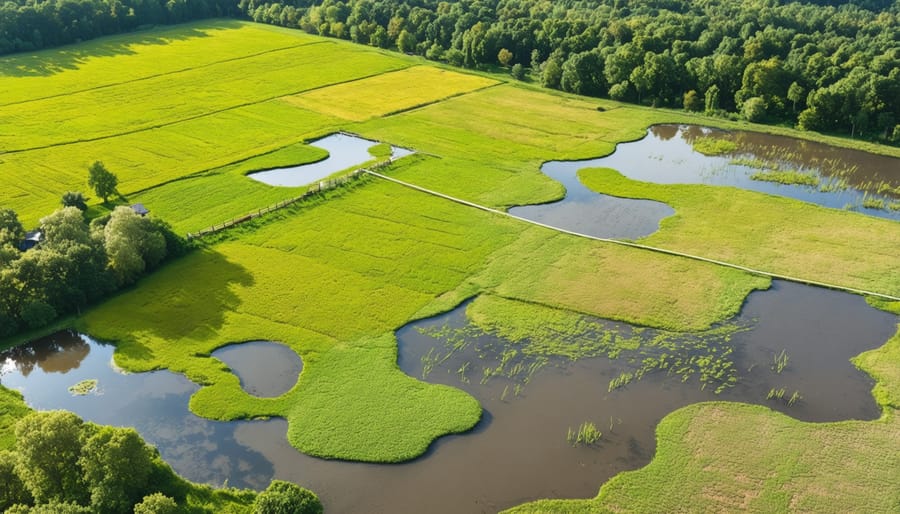
The Morrison Family Farm
Located just outside of Wetaskiwin, Alberta, the Morrison Family Farm has become a shining example of successful wetland carbon sequestration practices in the province. Third-generation farmer Sarah Morrison and her family made the bold decision in 2018 to restore 40 hectares of previously drained wetlands on their 640-hectare mixed farming operation.
“Initially, we were skeptical about taking productive land out of rotation,” Sarah explains. “But the degraded soil quality in those areas was already affecting our yields, and we knew something had to change.”
Working with Ducks Unlimited Canada and the Alberta ALUS program, the Morrisons developed a comprehensive restoration plan. The project involved re-establishing natural water flow patterns, planting native vegetation, and creating buffer zones around the wetland areas.
Three years into the project, the results have exceeded expectations. Soil organic carbon levels have increased by 23% in the restored areas, while water retention has significantly improved across the entire property. The farm has also seen the return of diverse wildlife, including several species of waterfowl and beneficial insects that help with natural pest control.
The Morrisons now serve as mentors to other local farmers interested in wetland restoration, hosting regular field days and sharing their experiences with the broader agricultural community. Their success demonstrates how wetland carbon sequestration can benefit both the environment and farm operations.
Community Impact
The restoration of wetlands brings substantial benefits that extend far beyond individual farm boundaries. In Alberta’s agricultural communities, wetland conservation projects have shown remarkable success in supporting local wildlife populations, particularly waterfowl and beneficial insects that aid in natural pest control. Farmers like Jim Anderson from Lacombe County report seeing increased bird diversity and the return of native species to their restored wetlands within just two growing seasons.
These projects also create natural water management systems that help buffer against both drought and flooding – a crucial advantage for farming communities facing increasingly unpredictable weather patterns. During dry spells, wetlands act as natural reservoirs, while in wet seasons, they reduce flood risks by absorbing excess water that might otherwise damage crops and infrastructure.
Local farming communities have discovered additional benefits through improved water quality and reduced soil erosion. The Alberta Wetland Conservation Program has documented how restored wetlands filter agricultural runoff, reducing the need for expensive water treatment systems. This natural filtration process helps maintain cleaner water sources for livestock and irrigation.
Moreover, wetland projects have become gathering points for community education and engagement. Several Alberta farms now host school field trips and community workshops, sharing knowledge about sustainable agriculture practices while building stronger connections between urban and rural residents. These initiatives have helped create a more unified approach to environmental stewardship while maintaining productive agricultural operations.
Financial Benefits and Support Programs
Government Incentives
Several government programs support Alberta farmers in their wetland conservation efforts. The Alberta Wetland Policy offers compensation for preserving existing wetlands, while the Environmental Farm Plan (EFP) provides funding for implementing wetland management practices. Farmers can access up to $70,000 through the Canadian Agricultural Partnership (CAP) for wetland restoration projects.
The Alternative Land Use Services (ALUS) program, active in several Alberta counties, offers annual payments for maintaining wetlands on agricultural land, typically ranging from $15 to $40 per acre. The Nature Conservancy of Canada also partners with local governments to provide matching funds for wetland conservation initiatives.
For carbon offset credits, Alberta’s Carbon Offset System allows farmers to earn credits for verified wetland conservation practices. These credits can be sold on the provincial carbon market, creating an additional revenue stream. The Wetland Restoration Credit Protocol specifically outlines how farmers can quantify and verify their wetland carbon sequestration efforts.
To access these programs, connect with your local Agricultural Fieldman or ALUS coordinator, who can guide you through the application process and help identify the most suitable programs for your operation.
Carbon Credit Opportunities
Alberta farmers can now turn their wetland conservation efforts into profitable ventures through emerging carbon credit opportunities. The Alberta Emission Offset System allows landowners to earn credits for verified carbon sequestration activities, including wetland restoration and preservation.
To participate, farmers need to register their wetland projects with approved verification bodies and document baseline carbon levels. Regular monitoring and reporting of sequestration rates are required, typically conducted by qualified environmental consultants. Credits can then be sold to industrial emitters seeking to meet their regulatory obligations.
Current market rates for carbon credits in Alberta range from $30 to $50 per tonne of CO2 equivalent, with prices expected to rise. A properly managed hectare of wetland can sequester between 2 and 5 tonnes of carbon annually, creating significant revenue potential.
Local agricultural extension offices provide support in navigating the certification process, and several farmer cooperatives have formed to share resources and expertise. Consider joining existing wetland carbon programs or partnering with neighboring properties to reduce verification costs and maximize returns.
As we’ve explored throughout this article, wetland carbon sequestration offers Alberta farmers a powerful opportunity to combat climate change while creating additional revenue streams. The science is clear: healthy wetlands are among our most effective natural carbon sinks, storing up to 40 times more carbon than forests on a per-area basis.
By preserving and restoring wetlands on your property, you’re not just contributing to environmental sustainability – you’re investing in your farm’s future. The benefits extend beyond carbon storage to include improved water quality, enhanced biodiversity, and natural flood control, all of which contribute to more resilient agricultural operations.
The financial incentives available through Alberta’s carbon offset program and various conservation initiatives make wetland preservation more economically viable than ever before. Many of your fellow farmers are already seeing returns on their wetland investments while building more sustainable operations for future generations.
We encourage you to take the first step today. Connect with local conservation authorities, explore available funding programs, and join the growing community of Alberta farmers leading the way in wetland stewardship. Remember, every hectare of wetland preserved or restored contributes to our collective goal of sustainable agriculture.
Together, we can maintain Alberta’s agricultural heritage while building a more climate-resilient future. Your wetlands are valuable assets – both for your farm and for our environment. Let’s make the most of them.

